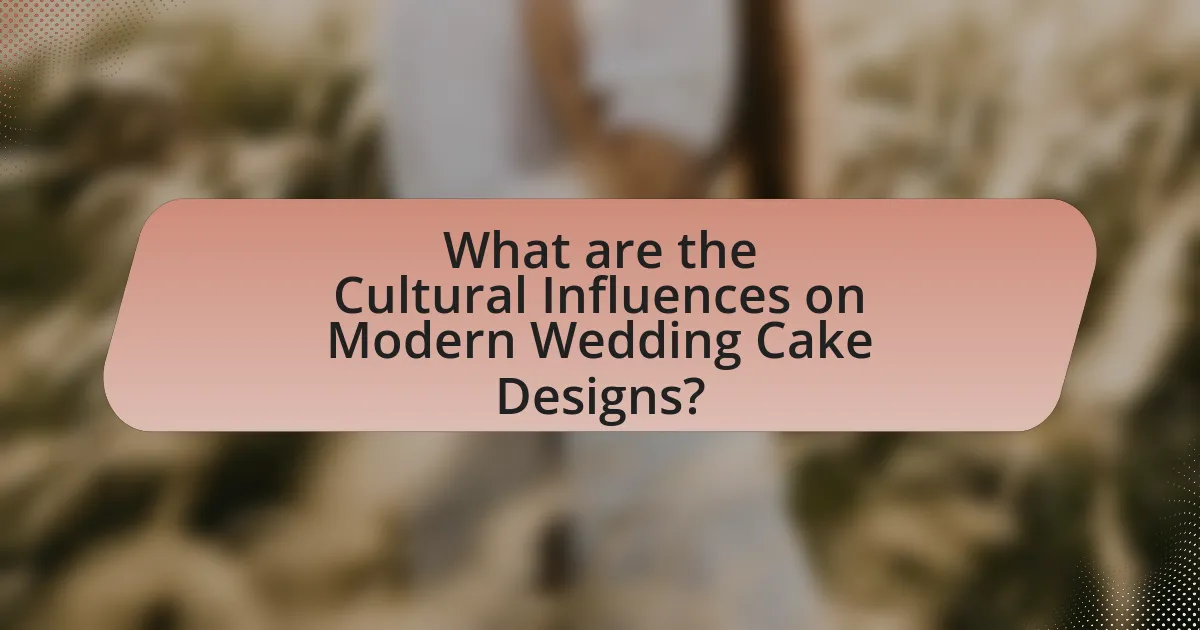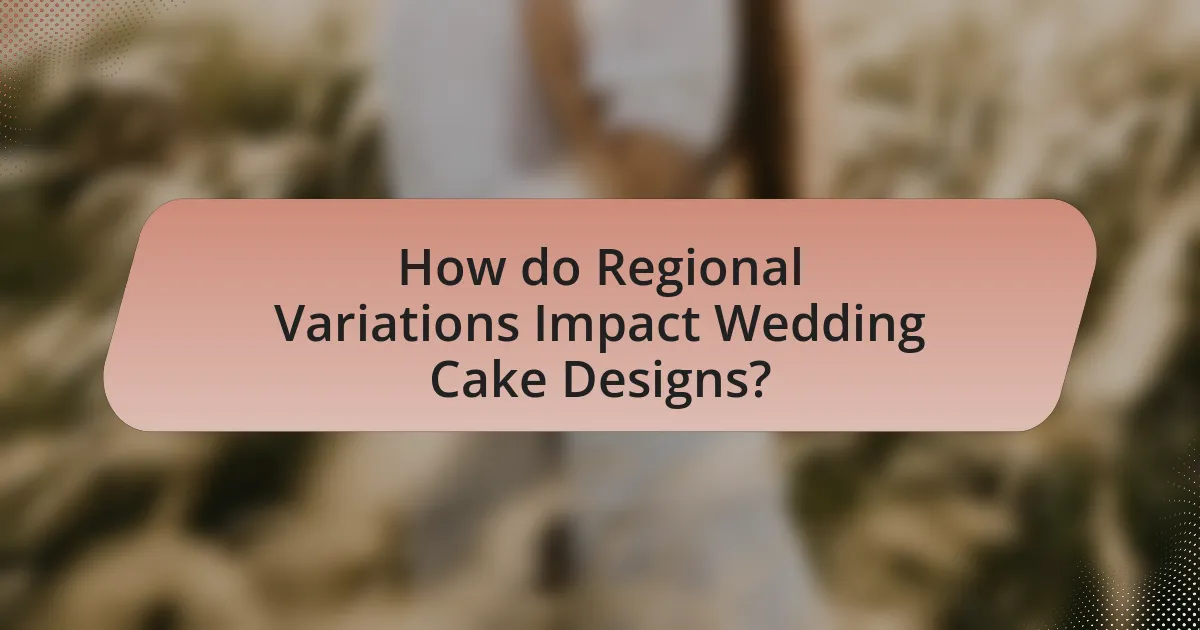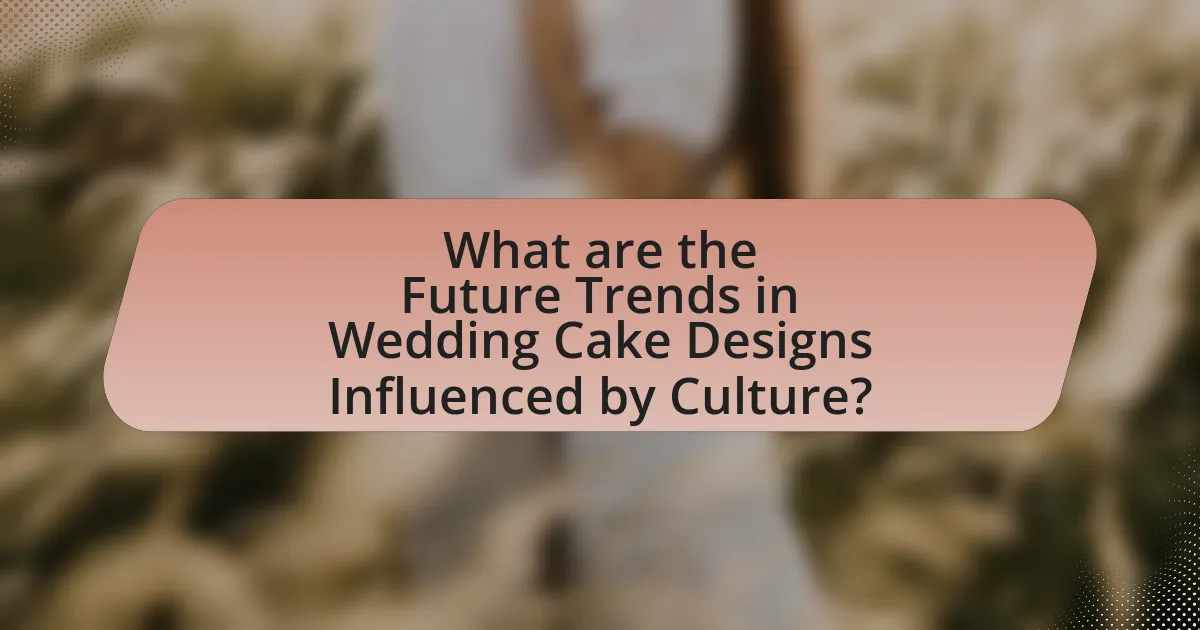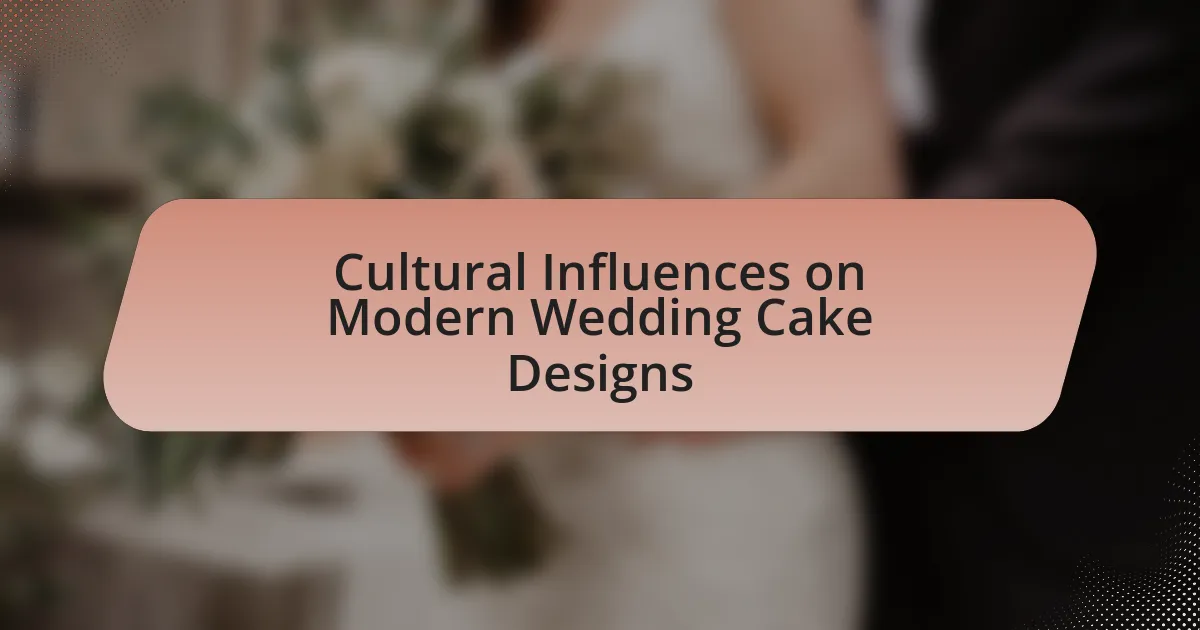The article examines the cultural influences on modern wedding cake designs, highlighting how regional traditions, historical practices, and contemporary trends shape aesthetics and flavors. It discusses the significance of wedding cakes across various cultures, including the symbolism of multi-tiered cakes in Western societies and the vibrant designs of Asian cakes. The piece also explores the incorporation of traditional elements, the impact of globalization on flavor combinations, and the role of social media in shaping cake trends. Additionally, it addresses best practices for blending cultural backgrounds in cake design while respecting traditions and fostering innovation.

What are the Cultural Influences on Modern Wedding Cake Designs?
Cultural influences on modern wedding cake designs include regional traditions, historical practices, and contemporary trends that reflect societal values. For instance, in Western cultures, multi-tiered cakes symbolize prosperity and celebration, often adorned with intricate decorations that represent the couple’s personal story or heritage. In contrast, Asian wedding cakes, such as the Chinese “longevity peach” cake, emphasize symbolism related to good fortune and long life, often featuring vibrant colors and specific shapes. Additionally, the rise of fusion weddings has led to the incorporation of diverse cultural elements, blending flavors and designs from various traditions, which reflects a growing appreciation for multiculturalism in modern society. This blending of styles showcases how cultural backgrounds shape the aesthetics and meanings behind wedding cakes today.
How do different cultures shape wedding cake aesthetics?
Different cultures significantly shape wedding cake aesthetics through unique traditions, flavors, and designs. For instance, in Western cultures, multi-tiered cakes adorned with intricate fondant and sugar flowers symbolize elegance and celebration, reflecting a trend that began in the Victorian era when elaborate cakes became a status symbol. In contrast, traditional Indian weddings often feature colorful, richly decorated cakes that incorporate local flavors like cardamom and saffron, showcasing the importance of vibrant colors and spices in Indian culinary culture. Additionally, in Japanese weddings, cakes may be designed to resemble traditional motifs such as cherry blossoms, emphasizing harmony and nature, which are central to Japanese aesthetics. These cultural variations illustrate how local customs and values influence the visual and taste elements of wedding cakes, making them a reflection of the couple’s heritage and identity.
What traditional elements are incorporated into modern designs?
Modern wedding cake designs incorporate traditional elements such as intricate lace patterns, tiered structures, and symbolic motifs. These elements reflect cultural heritage and craftsmanship, often seen in classic wedding cakes that feature detailed piping and floral decorations. For instance, the use of lace is derived from historical cake designs, where it symbolized elegance and sophistication, while tiered cakes represent abundance and celebration, rooted in longstanding wedding traditions. Additionally, motifs like doves or wedding rings are frequently included to signify love and unity, connecting contemporary designs to their historical origins.
How do cultural symbols influence flavor choices?
Cultural symbols significantly influence flavor choices by associating specific tastes with traditions and values. For instance, in many cultures, certain flavors are tied to celebrations and rituals; for example, vanilla is often used in Western weddings to symbolize purity, while red bean paste is favored in Asian weddings for its connotations of good fortune. These associations guide individuals in selecting flavors that resonate with their cultural identity and the significance of the event. Research indicates that flavor preferences are often shaped by cultural experiences and social contexts, reinforcing the idea that cultural symbols play a crucial role in determining flavor choices in wedding cake designs.
Why is the wedding cake significant in various cultures?
The wedding cake is significant in various cultures as it symbolizes prosperity, fertility, and the union of two individuals. In many traditions, the act of cutting the cake together represents the couple’s first task as a married pair, reinforcing their partnership. For instance, in ancient Rome, guests would break bread over the bride’s head to bestow good fortune, which evolved into the modern cake tradition. Additionally, in Western cultures, the multi-tiered cake signifies wealth and status, while in some Eastern cultures, cakes made from rice or other local ingredients reflect regional customs and beliefs. These practices highlight the wedding cake’s role as a central element in celebrating love and community across diverse cultural landscapes.
What historical events have shaped wedding cake traditions?
The historical events that have shaped wedding cake traditions include the Roman Empire’s use of wheat cakes during marriage ceremonies, which symbolized fertility and prosperity. In medieval England, the tradition evolved with the introduction of stacked cakes, where guests would try to kiss over the cake for good luck, leading to the multi-tiered designs seen today. The Victorian era further influenced wedding cakes with the introduction of elaborate icing and fruitcake, reflecting the period’s emphasis on opulence and celebration. These events collectively established the significance of wedding cakes as symbols of wealth, status, and celebration in modern weddings.
How do cultural beliefs affect the cake’s role in ceremonies?
Cultural beliefs significantly influence the role of cake in ceremonies by dictating its symbolism, design, and consumption practices. For instance, in many Western cultures, wedding cakes symbolize prosperity and fertility, often featuring multiple tiers to represent the couple’s future together. In contrast, in some Asian cultures, cakes may be designed to reflect traditional motifs and are often served as part of a larger meal, emphasizing community and family ties. Historical practices, such as the ancient Roman custom of breaking bread over the bride’s head, illustrate how cakes have evolved to embody various cultural significances, reinforcing their importance in ceremonial contexts.
What are the contemporary trends in wedding cake designs influenced by culture?
Contemporary trends in wedding cake designs influenced by culture include the incorporation of traditional motifs, flavors, and techniques from various cultures. For instance, many couples are opting for cakes that reflect their heritage, such as Indian-inspired cakes featuring vibrant colors and intricate henna designs, or Japanese wedding cakes that emphasize simplicity and elegance with matcha flavors and minimalistic aesthetics. Additionally, the use of local ingredients and flavors is becoming popular, as couples seek to celebrate their regional culture through unique tastes, such as incorporating local fruits or spices. This trend is supported by the growing interest in personalized and culturally significant wedding experiences, as evidenced by surveys indicating that 70% of couples prioritize cultural representation in their wedding planning.
How are fusion styles emerging in modern wedding cakes?
Fusion styles are emerging in modern wedding cakes by blending diverse cultural elements and flavors, reflecting the multicultural backgrounds of couples. This trend is evident in the incorporation of traditional designs from various cultures, such as Indian motifs, Japanese aesthetics, and Western cake structures, resulting in unique and personalized creations. For example, a cake may feature a classic tiered structure adorned with intricate henna patterns and flavored with matcha or chai, showcasing the harmonious integration of different culinary traditions. This approach not only celebrates the couple’s heritage but also appeals to a broader audience, as seen in the increasing popularity of fusion flavors like lavender and cardamom in wedding cake offerings.
What role does social media play in shaping cultural cake trends?
Social media significantly influences cultural cake trends by providing a platform for sharing visually appealing cake designs and innovative baking techniques. Platforms like Instagram and Pinterest allow users to showcase their creations, leading to viral trends that shape consumer preferences and inspire bakers worldwide. For instance, the rise of “naked cakes” and “geode cakes” can be traced back to their popularity on these platforms, where visually striking images garner likes and shares, thus driving demand. Additionally, social media facilitates the exchange of ideas and cultural practices, allowing bakers from diverse backgrounds to influence each other and create fusion designs that reflect a blend of traditions. This interconnectedness accelerates the evolution of cake trends, making social media a pivotal force in shaping contemporary cake culture.

How do Regional Variations Impact Wedding Cake Designs?
Regional variations significantly impact wedding cake designs by influencing flavors, ingredients, and decoration styles. For instance, in Italy, traditional wedding cakes often feature rich fruit and nut flavors, while in the United States, popular choices include vanilla and chocolate with elaborate fondant decorations. These regional preferences reflect local agricultural products and cultural traditions, such as the use of marzipan in European cakes or the incorporation of local fruits in tropical regions. Additionally, cultural practices, such as the significance of certain colors or symbols in different cultures, further shape the aesthetic and thematic elements of wedding cakes. This diversity in design showcases how regional customs and tastes directly inform the creation of wedding cakes, making them a unique representation of local heritage.
What are the key regional differences in wedding cake styles?
Key regional differences in wedding cake styles include variations in flavor, design, and cultural significance. For instance, in the United States, multi-tiered cakes are common, often adorned with elaborate decorations and fondant, reflecting a trend towards opulence. In contrast, traditional Italian wedding cakes, such as the Millefoglie, feature layers of puff pastry and cream, emphasizing simplicity and rich flavors. In the UK, fruitcakes are popular, often soaked in alcohol and covered with marzipan, symbolizing longevity and prosperity. These differences are influenced by local ingredients, historical practices, and cultural traditions, showcasing how regional customs shape wedding cake styles.
How do climate and local ingredients influence cake designs?
Climate and local ingredients significantly influence cake designs by dictating the types of flavors, textures, and decorations that are feasible and appealing in specific regions. For instance, in warmer climates, cakes may incorporate lighter, fruit-based flavors and use ingredients like coconut or tropical fruits, which are abundant and refreshing. Conversely, in cooler climates, richer flavors such as chocolate or spices may be more popular, reflecting local preferences and seasonal availability.
Additionally, local ingredients often shape the aesthetic of cake designs; for example, cakes in regions known for their floral diversity may feature edible flowers as decorations, while areas with a strong agricultural presence might utilize locally sourced nuts or grains. This connection to local produce not only enhances the flavor profile but also creates a visual representation of the region’s culture and environment, making the cake a reflection of its geographical context.
What unique flavors are popular in different regions?
Unique flavors popular in different regions include red velvet in the Southern United States, which is characterized by its rich cocoa flavor and cream cheese frosting. In Italy, tiramisu flavor, combining coffee and mascarpone, is favored for its indulgent taste. In Japan, matcha, a finely ground green tea, is celebrated for its earthy flavor and vibrant color. In Mexico, tres leches cake, soaked in three types of milk, offers a moist and sweet experience. These flavors reflect local ingredients and cultural preferences, influencing modern wedding cake designs.
How do local customs affect wedding cake presentation?
Local customs significantly influence wedding cake presentation by dictating design elements, flavors, and serving traditions. For instance, in many Western cultures, multi-tiered cakes symbolize prosperity and are often elaborately decorated, reflecting the couple’s personal style and the event’s formality. In contrast, in some Asian cultures, cakes may be less prominent, with traditional desserts like mooncakes or rice cakes being favored, emphasizing cultural heritage over elaborate presentation. Additionally, specific customs, such as the cutting of the cake in Western weddings, serve as a ritual that highlights the couple’s unity, while in other cultures, the cake may be served to guests as a symbol of sharing joy. These variations illustrate how local customs shape not only the aesthetics but also the significance of wedding cake presentation across different cultures.
What are the common practices for serving wedding cakes in various cultures?
Common practices for serving wedding cakes vary significantly across cultures. In Western cultures, it is customary for the couple to cut the cake together, symbolizing their first act as a married couple, after which the cake is served to guests. In Italy, the tradition includes a multi-tiered cake called “millefoglie,” which is often served with a celebratory toast. In India, wedding cakes are less common, with sweets like “mithai” being served instead, but when cakes are included, they are often elaborately decorated and served at the reception. In Japan, a traditional wedding cake called “shiroi keki” is served, typically made of white sponge and decorated with fresh fruits. These practices reflect cultural values and traditions surrounding marriage and celebration, illustrating the diversity in how wedding cakes are integrated into wedding ceremonies worldwide.
How do regional celebrations influence cake size and decoration?
Regional celebrations significantly influence cake size and decoration by reflecting local customs, traditions, and preferences. For instance, in cultures where large gatherings are common, such as weddings in India, cakes are often made larger to accommodate numerous guests, while intricate decorations symbolize prosperity and joy. In contrast, smaller, more intimate celebrations in regions like Scandinavia may feature simpler, modestly sized cakes adorned with minimalistic designs, emphasizing elegance over extravagance. These variations are rooted in cultural significance; for example, the use of specific colors or motifs in cake decoration can represent local beliefs or festivities, such as the use of red and gold in Chinese weddings to symbolize good fortune. Thus, regional celebrations shape both the dimensions and aesthetic choices of cakes, ensuring they resonate with the cultural context of the event.

What are the Future Trends in Wedding Cake Designs Influenced by Culture?
Future trends in wedding cake designs influenced by culture include the incorporation of diverse cultural motifs, flavors, and sustainable practices. As couples increasingly seek to reflect their heritage, designs featuring traditional symbols, colors, and patterns from various cultures are becoming popular. For instance, Indian weddings often showcase intricate henna designs, while Japanese weddings may feature minimalist aesthetics with cherry blossom motifs. Additionally, flavors are diversifying, with couples opting for regional specialties, such as matcha or cardamom, to represent their backgrounds. Sustainability is also a growing trend, with many couples choosing locally sourced ingredients and eco-friendly materials, reflecting a cultural shift towards environmental consciousness. These trends are supported by the rise of multicultural weddings, which have increased by 28% in recent years, highlighting the demand for culturally inspired designs.
How are sustainability and cultural heritage shaping future designs?
Sustainability and cultural heritage are significantly shaping future designs by promoting eco-friendly materials and traditional techniques. Designers are increasingly incorporating locally sourced, organic ingredients and biodegradable packaging to minimize environmental impact, reflecting a growing consumer demand for sustainable practices. Additionally, cultural heritage influences the aesthetic and symbolic elements of designs, as artisans draw on traditional motifs and methods that resonate with specific cultural narratives. For instance, the use of traditional cake decoration techniques, such as sugar flowers or intricate piping, not only preserves cultural identity but also enhances the uniqueness of modern wedding cakes. This integration of sustainability and cultural heritage ensures that future designs are not only visually appealing but also ethically responsible and culturally meaningful.
What innovative techniques are being adopted in cake decoration?
Innovative techniques being adopted in cake decoration include the use of edible printing, 3D printing, and airbrushing. Edible printing allows for high-resolution images and intricate designs to be transferred onto cakes, enhancing personalization and creativity. 3D printing technology enables the creation of complex cake toppers and decorations that were previously difficult to achieve by hand. Airbrushing provides a way to apply color gradients and detailed designs smoothly, giving cakes a professional finish. These techniques reflect a trend towards customization and artistic expression in modern cake design, aligning with cultural influences that prioritize unique and visually striking wedding cakes.
How is the demand for personalized cakes reflecting cultural diversity?
The demand for personalized cakes reflects cultural diversity by showcasing unique flavors, designs, and themes that represent various cultural traditions and celebrations. For instance, many couples now incorporate elements from their heritage into wedding cakes, such as specific cultural motifs, traditional ingredients, or symbolic colors, which highlights the blending of different cultural backgrounds. According to a survey conducted by The Knot in 2022, 45% of couples reported including cultural elements in their wedding cakes, indicating a significant trend towards personalization that honors diverse backgrounds. This trend not only caters to individual preferences but also fosters inclusivity and appreciation for multiculturalism in modern celebrations.
What role do modern technologies play in evolving wedding cake designs?
Modern technologies significantly enhance wedding cake designs by enabling intricate customization and precision in decoration. Techniques such as 3D printing allow bakers to create detailed cake toppers and unique shapes that were previously difficult to achieve by hand. Additionally, digital design software facilitates the visualization of cake concepts, enabling couples to collaborate closely with bakers to realize their specific visions. The use of advanced baking equipment, like temperature-controlled ovens and precision scales, ensures consistent quality and texture, which are crucial for modern aesthetic standards. These technological advancements not only streamline the baking process but also expand the creative possibilities, reflecting contemporary trends and personal styles in wedding celebrations.
How are 3D printing and digital design impacting cultural cake aesthetics?
3D printing and digital design are significantly transforming cultural cake aesthetics by enabling intricate, customizable designs that reflect diverse cultural motifs and personal narratives. This technology allows bakers to create complex shapes and patterns that were previously difficult or impossible to achieve with traditional methods, thus broadening the scope of artistic expression in cake design. For instance, 3D printing can replicate traditional cultural symbols, such as mandalas in Indian weddings or lace patterns in European cakes, with precision and detail. Additionally, digital design software facilitates collaboration among bakers and clients, allowing for personalized cakes that resonate with individual cultural backgrounds and preferences, thereby enhancing the cultural significance of wedding cakes in contemporary celebrations.
What future trends can we expect in flavor combinations influenced by globalization?
Future trends in flavor combinations influenced by globalization will likely include the fusion of traditional and contemporary tastes, resulting in unique pairings such as matcha with vanilla, or cardamom with chocolate. This trend is driven by the increasing accessibility of diverse ingredients and culinary techniques from around the world, allowing bakers to experiment with flavors that reflect a blend of cultural heritages. For instance, the rise of Asian-inspired flavors in Western desserts, such as yuzu or black sesame, showcases how globalization is reshaping palates and preferences. Additionally, the popularity of plant-based and health-conscious ingredients is leading to innovative combinations that cater to a broader audience, further enhancing the diversity of flavor profiles in wedding cakes.
What are some best practices for incorporating cultural influences into wedding cake designs?
Incorporating cultural influences into wedding cake designs involves understanding and respecting the traditions and symbols of the cultures being represented. Best practices include researching specific cultural elements, such as traditional flavors, colors, and motifs, to ensure authenticity. For example, a couple of Indian heritage might choose flavors like cardamom or saffron and incorporate henna patterns into the cake design. Additionally, collaborating with bakers who specialize in cultural cakes can enhance the design’s authenticity and execution. This approach not only honors the couple’s heritage but also creates a unique and meaningful centerpiece for the wedding celebration.
How can couples effectively blend their cultural backgrounds in cake design?
Couples can effectively blend their cultural backgrounds in cake design by incorporating traditional elements from each culture into a cohesive design. For example, they can select flavors, colors, and decorative motifs that represent their heritages, such as using a specific type of frosting or cake style that is significant in one culture while integrating symbols or patterns from the other. This approach not only honors both backgrounds but also creates a unique cake that tells their story. Research indicates that personalized wedding cakes that reflect cultural diversity enhance the overall wedding experience, making it memorable for both the couple and their guests.
What tips can bakers follow to respect cultural traditions while innovating?
Bakers can respect cultural traditions while innovating by thoroughly researching the cultural significance of traditional ingredients and techniques. Understanding the historical context and symbolism behind specific flavors, designs, and baking methods allows bakers to incorporate these elements thoughtfully into their creations. For instance, using traditional spices or motifs in a modern cake design can honor cultural heritage while appealing to contemporary tastes. Additionally, collaborating with cultural experts or community members can provide insights that enhance authenticity and respect. This approach not only preserves cultural integrity but also fosters creativity, resulting in unique and meaningful baked goods that resonate with diverse audiences.
